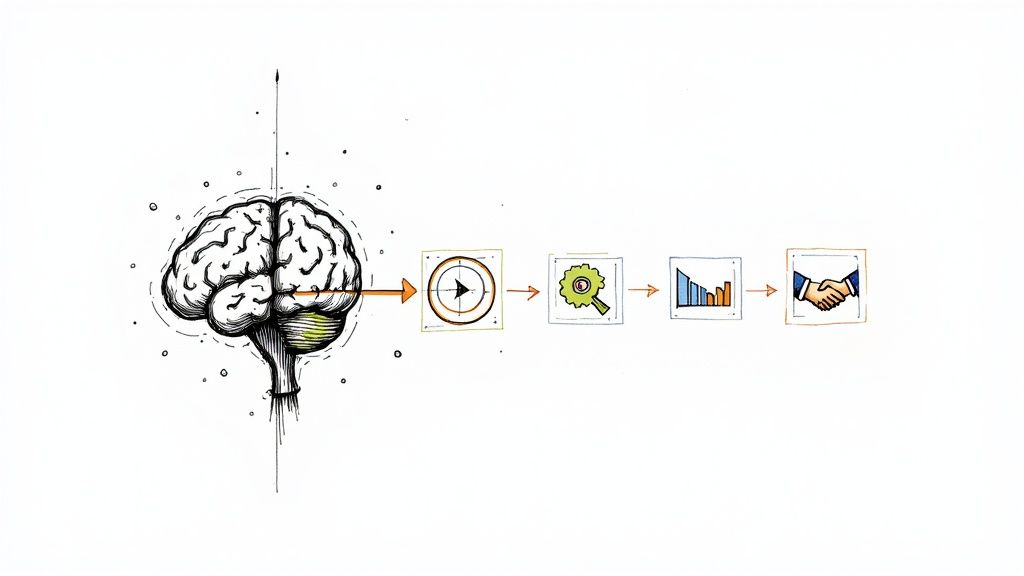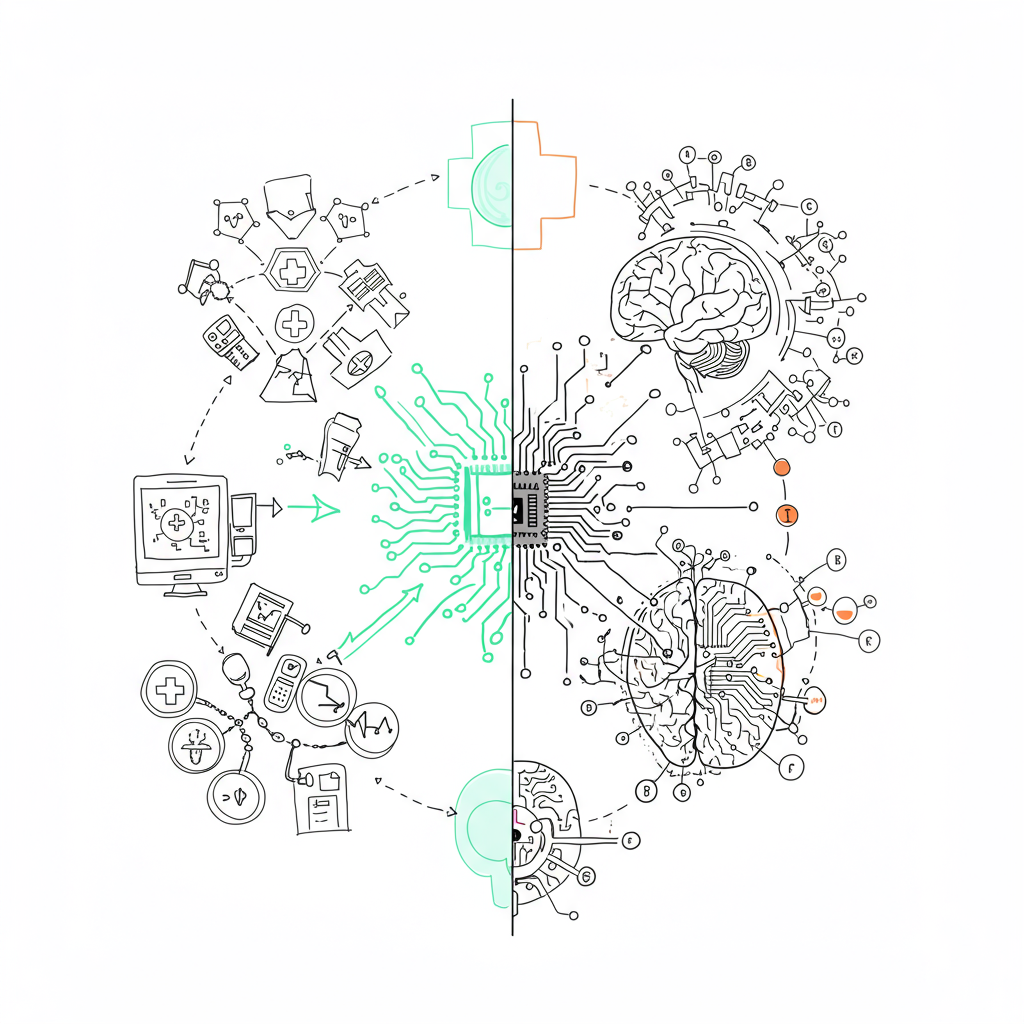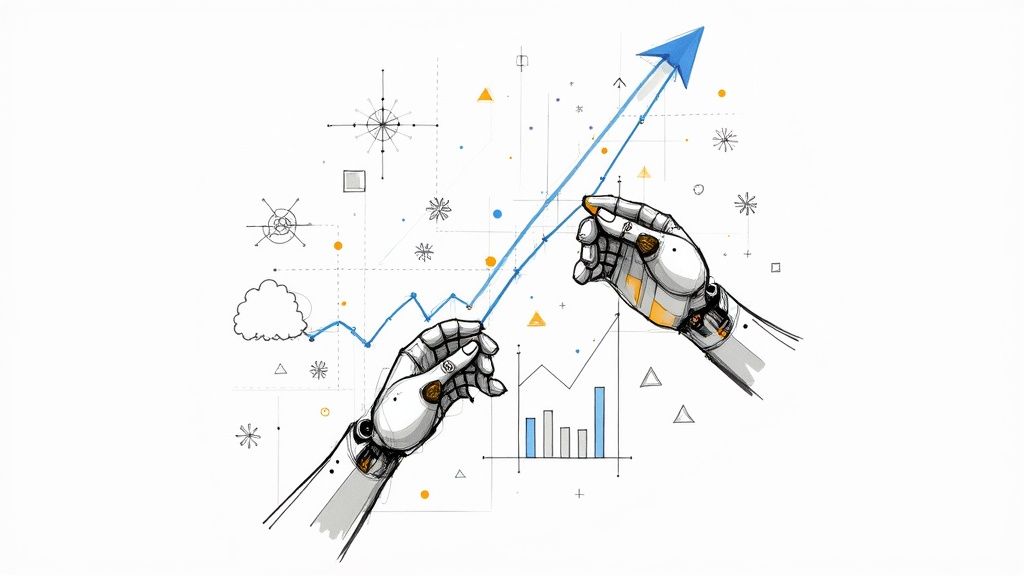Your Guide to AI in Business Strategy
Unlock growth with a winning AI in business strategy. This guide offers a practical framework and real-world examples for transforming your company with AI.

Integrating AI into your business strategy is no longer a forward-thinking idea; it's a fundamental requirement for staying in the game. It means weaving artificial intelligence into the fabric of your core operations, from refining processes and unlocking new avenues for growth to making sharper, faster decisions.
Why AI is Your New Competitive Edge
It’s easy to see AI as just another tool in the box, but that’s a real missed opportunity. A better way to think about it is like the new electricity for your company—a foundational resource that energises every single department. When you have a well-thought-out AI in business strategy, you move beyond automating simple tasks and start building the central nervous system of your entire organisation.
This shift allows you to stop reacting to market changes and start predicting them. AI can sift through enormous datasets in real-time, spotting patterns and insights that a human team could never catch on their own. Suddenly, decision-making transforms from a process based on what happened yesterday into one guided by what’s likely to happen tomorrow.
Powering Growth and Innovation
 The real magic of a solid AI strategy is its power to create a competitive advantage that lasts. When AI is truly embedded in your operations, it doesn’t just improve what you already do; it helps you invent entirely new ways to deliver value to your customers.
The real magic of a solid AI strategy is its power to create a competitive advantage that lasts. When AI is truly embedded in your operations, it doesn’t just improve what you already do; it helps you invent entirely new ways to deliver value to your customers.
For example, a smart strategy can unlock:
Hyper-Personalised Customer Experiences: By figuring out what individual customers need before they even ask.
Highly Efficient Supply Chains: Through incredibly accurate demand forecasting and automated logistics.
Breakthrough Product Development: By speeding up research and simulating thousands of potential outcomes.
This approach is catching on fast. Recent data shows that AI adoption is picking up serious speed within the German economy. A study from the ifo Institute revealed that 40.9% of companies in Germany are already using AI in some form, which shows a strong belief in its ability to boost efficiency and secure a market advantage. You can dig deeper into these German business trends and findings for more context.
The Core Pillars of an AI-Driven Business Strategy
To build a strategy that works, it's helpful to break it down into its core components. Each pillar plays a distinct role in turning AI from a concept into a tangible business asset.
Strategic Pillar | Primary Objective | Key Business Impact |
|---|---|---|
Data Foundation | To centralise and prepare high-quality data for AI analysis. | Enables more accurate predictions and reliable insights across the board. |
Operational Integration | To embed AI tools directly into daily workflows and processes. | Increases efficiency, reduces manual error, and frees up teams for strategic work. |
Intelligent Automation | To automate complex tasks and decision-making where possible. | Speeds up operations, lowers costs, and improves consistency in output. |
Strategic Foresight | To use predictive analytics for market and customer trend analysis. | Allows the business to anticipate change and make proactive decisions. |
By focusing on these pillars, a business can create a coherent and powerful strategy that ensures AI is not just a side project but a central driver of success.
From Technology to Strategic Asset
Ultimately, building AI into your core strategy is about creating a more resilient, intelligent, and adaptable organisation. It’s the difference between a company that follows trends and one that sets them.
An effective AI strategy doesn’t just support the business; it becomes the business. It’s the engine for smarter decisions, deeper customer relationships, and sustained market leadership in an increasingly complex world.
This fundamental reorganisation of a company around data creates a powerful flywheel. The more data the AI processes, the smarter it gets. The smarter it gets, the better the business outcomes. It’s this self-reinforcing cycle of improvement that truly separates the leaders from the laggards.
Understanding the Three Levels of AI Integration
Bringing AI into your business isn't some monolithic, all-or-nothing event. It's far more practical to think of it as a journey, moving through distinct stages. This approach lets you build your capabilities over time, show tangible results along the way, and manage the change without overwhelming your teams.
When you break it down like this, the whole process feels much less intimidating. Each level represents a deeper connection between technology and human expertise, creating value in different ways. The first step is simply figuring out where your business is right now so you can plan your next move.
Level 1: Assisted Intelligence
The most common and accessible entry point is Assisted Intelligence. At this stage, AI acts as a straightforward tool that helps people do their existing jobs better. It's all about boosting efficiency and accuracy by automating routine, and often repetitive, tasks.
Think about the predictive text on your phone or the grammar checker in your word processor. These tools don't make decisions for you, but they certainly make your work quicker and more precise. In a business setting, this could mean:
Data Analysis Tools: Software that automatically sorts and visualises sales figures, helping an analyst spot trends in minutes instead of hours.
CRM Enhancements: Systems that suggest the best time to contact a lead, based on their history of interactions.
This level is about improving what you already do. It doesn't radically change your business model but delivers clear, measurable efficiency gains. That makes it a low-risk, high-reward starting point for any business looking to adopt AI.
Level 2: Augmented Intelligence
The next step up is Augmented Intelligence, where people and AI start to collaborate in a much more dynamic way. This goes beyond simple automation to help with complex decision-making. The AI provides deep insights and data-driven recommendations, but the human expert brings context, experience, and the final judgement call.
A perfect example comes from modern medicine. An AI can analyse thousands of medical scans to flag potential issues for a radiologist to review. The AI does the heavy lifting, but the doctor, with their years of experience, makes the final diagnosis. This "human-in-the-loop" model ensures both precision and accountability.
In German industries, this might look like:
Manufacturing: An AI system constantly analyses sensor data from factory machines to predict when a part might fail. A maintenance engineer then uses this forecast to schedule repairs proactively, avoiding expensive downtime.
Finance: An AI platform flags unusual transaction patterns that could indicate fraud. A financial analyst then investigates these alerts to confirm if they are real threats.
This collaborative approach blends the raw computational power of machines with the subtle understanding of human experts, leading to far better outcomes.
At its core, Augmented Intelligence creates a powerful synergy. The AI enhances human intellect, empowering your team to tackle more complex problems and make smarter, more confident decisions.
Level 3: Autonomous Intelligence
The most advanced stage is Autonomous Intelligence. Here, AI systems can operate and make decisions with little to no human oversight. These systems learn from their surroundings and adapt their actions over time to hit specific goals. This is where AI stops being just a supportive tool and becomes more of an independent agent.
Self-driving vehicles used in logistics and warehouse management are a classic example. These machines navigate complex spaces, manage tasks, and optimise their own routes. The real value here is in creating entirely new ways of operating that simply weren't possible before.
The infographic below highlights some of the key business benefits that are driving companies toward deeper AI integration.
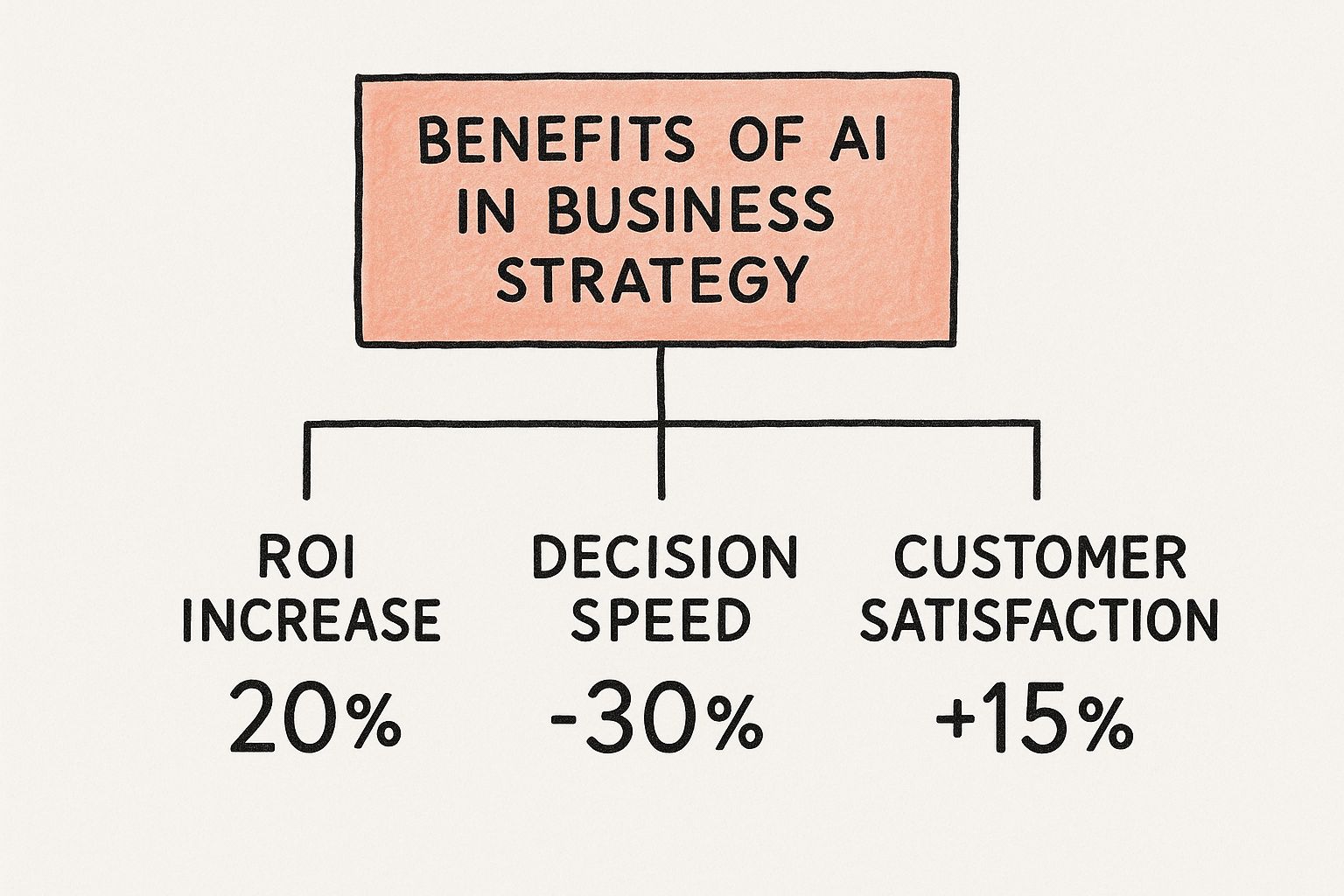
As the graphic shows, moving through these levels can lead to big improvements in ROI, decision speed, and customer satisfaction.
Getting to this level requires a sophisticated data infrastructure, strong governance, and a great deal of trust in the technology. While full autonomy might be the end goal for some functions, most businesses will find the greatest value in a smart mix of all three levels—applying the right degree of AI to the right problem. Understanding this spectrum is essential for building a realistic and impactful AI in business strategy.
Building Your AI Strategy From the Ground Up

Crafting a solid AI in business strategy isn't about jumping on the latest tech trend. It's a deliberate process, one that starts with your unique business challenges and grows from there. Think of it as a detailed roadmap, guiding your company from early curiosity all the way to measurable, real-world results.
This isn’t about making one giant leap. It’s about taking a series of smart, calculated steps. By breaking the journey down, even German SMEs can move from the drawing board to successful implementation, making sure every move builds on the last to create a smarter, more resilient business.
Step 1: Identify High-Impact Business Problems
So many companies make the same initial mistake: they find a cool AI tool and then desperately search for a problem it can solve. This is backwards. The right way to begin is by asking, "Where are our biggest pain points or most promising opportunities?"
Zero in on the areas where an improvement would genuinely move the needle. Are you battling inefficient supply chains, losing customers, or bogged down by slow product development? These are the perfect places to start.
When you frame the initiative around a clear business need, getting buy-in from the rest of the team becomes much easier. The conversation shifts from a technical one about algorithms to a strategic one about solving tangible problems and creating real value.
Step 2: Assess Your Data Readiness
At its core, AI runs on data. Without high-quality, accessible, and relevant data, even the most sophisticated algorithm is completely useless. Before you even think about a big project, you need to take an honest look at your data situation.
Data is the fuel for your AI engine. If you feed it poor-quality fuel, you can’t expect high performance. Your data must be clean, organised, and ready for analysis.
This means asking some tough questions:
Is our data clean? Is it riddled with errors, duplicates, or weird inconsistencies?
Is it accessible? Can your teams and any new AI systems get to the data they need, or is it locked up in separate, disconnected silos?
Is it relevant? Does the information you have actually connect to the business problem you're trying to solve?
Answering these questions early on is absolutely critical. Investing in good data governance and infrastructure isn’t just a pre-requisite for AI; it's a fundamental upgrade for your entire business.
Step 3: Launch a Pilot Project
Forget trying to overhaul the entire company at once. Start small with a pilot project. The goal here is simple: prove the concept and learn as much as you can, with minimal risk. A good pilot focuses squarely on one of the high-impact problems you’ve already identified.
For example, a German manufacturing firm could pilot a predictive maintenance AI on a single production line. The objective would be crystal clear: demonstrate a measurable drop in downtime or a reduction in maintenance costs.
Success is defined by hard numbers. A successful pilot doesn't just give you a compelling business case for more investment; it teaches you invaluable lessons about what works (and what doesn't) in your specific company culture.
Step 4: Develop Talent and Partnerships
Putting an AI in business strategy into action demands specialised skills. Broadly speaking, you have two options for getting this expertise: growing your own talent in-house or bringing in strategic partners.
Training and upskilling your current employees is a fantastic long-term investment that builds a sustainable, internal capability. But it does take time. For quicker wins, partnering with external AI specialists or dedicated firms can give you a major head start. You can learn more about how to build a powerful AI roadmap with expert guidance to fill any immediate skills gaps.
Germany’s national commitment to expanding its AI ecosystem is also a huge asset here. The High-Tech Strategy 2025 names AI as a key pillar for economic growth, with the government funnelling billions into supporting innovation. This fosters a vibrant environment for finding both talent and partners.
Step 5: Scale Your Success
Once your pilot project has proven its worth, the final step is to scale that success across the wider organisation. This means taking everything you learned from the pilot and creating a repeatable process for rolling it out elsewhere.
This phase demands careful planning around technology integration, managing organisational change, and providing ongoing training. The secret is to expand methodically, ensuring each new deployment is just as successful as the first. This gradual, evidence-led scaling is what turns AI from an interesting experiment into a core part of how you do business, driving continuous improvement and a real, lasting edge over the competition.
Seeing AI in Action: German Businesses Lead the Charge
Theory is one thing, but seeing AI at work in the real world is where its true value becomes clear. Across Germany, companies are no longer just talking about AI; they're putting it to work. From the titans of the automotive industry to the specialised manufacturing firms of the Mittelstand, AI is already solving tangible, high-stakes problems.
These examples aren't confined to a single industry. Instead, they highlight just how adaptable AI is, driving everything from efficiency and precision to genuine innovation. Looking at how others are succeeding provides a practical roadmap for businesses ready to take their own first steps.
Precision Engineering Meets Predictive Power in Automotive
Germany's automotive sector, a true cornerstone of the economy, is a natural pioneer in applying AI. For these giants, even a tiny improvement in efficiency or safety translates into enormous financial gains. One of the most impactful applications we're seeing is predictive maintenance on the factory floor.
Forget waiting for a critical machine to break down and grind production to a halt. Manufacturers now use AI to constantly analyse a flood of data from sensors on their equipment. These algorithms learn the unique operational "heartbeat" of each machine. When they spot subtle changes that signal a future failure, they alert maintenance teams long before the problem becomes critical. This simple shift from reactive to proactive keeps the assembly lines moving and slashes costly downtime.
At the same time, AI is the engine driving the development of autonomous vehicles. These systems need to process staggering amounts of visual and sensor data to make life-or-death decisions in a fraction of a second. German carmakers use AI to run billions of kilometres in virtual simulations, training their models far more rapidly and safely than is possible with physical test cars alone. It's a fundamental part of staying ahead in a fiercely competitive global race.
The real strategy here isn’t just about putting AI into a car. It's about building an entire automotive ecosystem powered by intelligent, connected systems. This reframes the vehicle from a simple product into a dynamic platform for ongoing services and updates.
Smart Factories and the Mittelstand
Germany's famous Mittelstand—the thousands of small and medium-sized manufacturing businesses that form the backbone of the economy—is also embracing AI. For these highly specialised companies, the goal is to build "smart factories" that refine their world-renowned efficiency even further.
AI-powered systems are helping them get a much tighter grip on complex supply chains. By analysing everything from historical sales figures and market trends to external factors like weather, AI can forecast demand with incredible accuracy. This helps businesses manage their inventory far more effectively, cutting waste and ensuring the right parts are always on hand.
Inside the factory, AI-driven visual inspection is quickly becoming the new standard. These systems can spot microscopic defects on a fast-moving production line with a consistency that's impossible for a human inspector to maintain over an eight-hour shift. This doesn't just boost quality control; it frees up skilled workers to tackle more complex, high-value tasks.
AI Applications Across Key German Industries
The influence of AI goes far beyond the factory floor. Let's take a quick look at how other major sectors are putting the technology to work to solve their own unique challenges.
The table below offers a snapshot of AI adoption across Germany, showing how different industries are applying it to drive specific, valuable outcomes.
Industry Sector | Primary AI Application | Example Business Outcome |
|---|---|---|
Financial Services | Real-time fraud detection and risk analysis. | Reduces financial losses by identifying and blocking suspicious transactions instantly, protecting both the bank and its customers. |
Healthcare | Analysis of medical imaging and patient data. | Supports doctors in making faster, more accurate diagnoses by identifying patterns in X-rays, MRIs, or genetic data. |
Retail & E-commerce | Personalised product recommendation engines. | Increases customer loyalty and sales by suggesting products that are genuinely relevant to an individual shopper's tastes and behaviour. |
As you can see, the applications are tailored to the specific needs of each sector, from mitigating risk in finance to enhancing care in healthcare.
Finance and Healthcare Innovations
In the financial world, banks are using machine learning to sift through millions of transactions every second to spot fraud. These intelligent systems learn the subtle fingerprints of illicit activity, flagging suspicious behaviour much more reliably than older, rule-based software. It’s a critical layer of defence in a world where security is paramount.
Meanwhile, Germany's healthcare sector is using AI to directly improve patient outcomes. AI tools are being developed to help radiologists analyse complex medical scans like MRIs and CTs. The technology can highlight potential areas of concern that might otherwise be missed, acting as a powerful co-pilot for the doctor. This isn't about replacing human expertise, but augmenting it to achieve earlier, more accurate diagnoses—a perfect example of man and machine working together for a better result.
Navigating the Challenges of AI Implementation
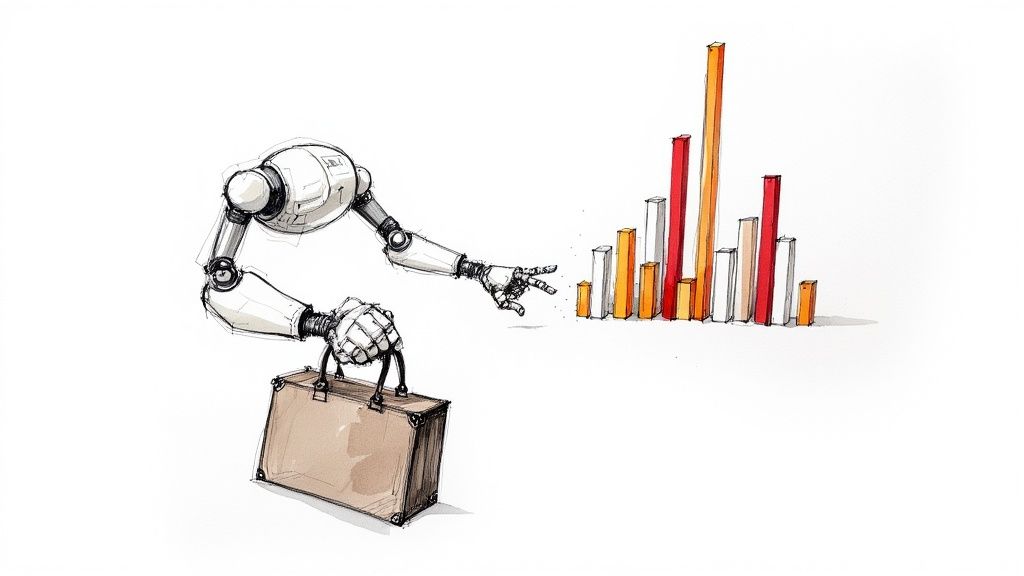
While the benefits of weaving AI into a business strategy are undeniably attractive, the journey to get there is rarely a straight line. It's often filled with tricky hurdles. The first, and most important, step is to honestly acknowledge these potential obstacles. Doing so allows you to build a resilient plan that can handle the complexities of the real world.
Successfully bringing AI into your operations is about more than just buying the latest software. It requires a realistic look at the potential pitfalls, from the steep costs and resource demands to the urgent need for specialised skills and the very human challenge of managing change.
The High Cost and Resource Drain
Let's start with the most immediate barrier: the significant upfront investment. Developing, implementing, and then maintaining AI systems can be a costly endeavour, demanding a lot of financial and computational power. This isn't just about software licences; you also have to factor in costs for data infrastructure, cloud computing, and the non-stop work of keeping everything running smoothly.
Many businesses simply underestimate the sheer volume of resources needed to launch an AI project and keep it going. This financial pressure makes it smart to start small. Kicking off with high-impact pilot projects can demonstrate a clear return on investment, making it much easier to justify further spending down the line.
Data Privacy and Ethical Concerns
In an age of tight data protection, navigating privacy isn't just a suggestion—it's paramount. When you handle vast datasets, especially those containing personal information, you take on an enormous responsibility. Complying with regulations like the GDPR is non-negotiable. One small misstep can lead to hefty fines and, worse, a complete loss of customer trust.
But it goes beyond just following the law. There’s the crucial issue of ethical AI. An algorithm is only as good—and as unbiased—as the data it learns from. If your data reflects historical biases, the AI will not only learn them but amplify them, leading to unfair or even discriminatory outcomes.
Building ethical guardrails into your AI strategy from day one isn't just good practice; it's a fundamental requirement for sustainable and responsible innovation. This means actively working to prevent algorithmic bias and ensuring your AI systems make decisions transparently.
This focus on responsible AI is also becoming a national priority. The German government recently established the Federal Ministry for Digital and Government Modernisation (BMDS) to accelerate AI's role in business while coordinating the implementation of rules like the EU AI Act. You can read more about how this initiative aims to invigorate Germany’s AI competitiveness.
The Talent Shortage and Skills Gap
Another major bottleneck is the global shortage of skilled AI professionals. Finding data scientists, machine learning engineers, and AI specialists who can actually build and manage these complex systems is incredibly competitive and expensive. Frankly, many organisations just can't find the people they need.
This reality makes upskilling your existing workforce an absolutely essential part of any successful AI in business strategy. You need a concrete plan to train your current employees, giving them the skills to work alongside these new intelligent systems.
This internal development can be turbocharged with expert-led training. For teams looking to fast-track their skills, an AI transformation workshop can be a powerful way to bridge critical knowledge gaps and get everyone on the same page.
Overcoming Organisational Resistance
Finally, we come to the biggest challenge of all. The technology itself is often the easy part; changing how people think and work is the real test. Employees might worry that AI will make their jobs obsolete, leading to pushback and a failure to adopt the new tools. If your team doesn't understand or trust the new systems, even the most brilliant AI strategy will fall flat.
This is where effective change management becomes vital. It involves:
Clear Communication: Being open and honest about the 'why' behind any AI initiatives. Explain how these tools will augment human roles, not simply replace them.
Inclusive Involvement: Bring employees from different departments into the design and testing phases. This builds a sense of ownership and makes them part of the solution.
Demonstrable Benefits: Show your teams exactly how AI can take over tedious tasks, freeing them up for more interesting, strategic, and fulfilling work.
Successfully getting past these challenges requires a thoughtful, proactive approach. By anticipating these issues before they become major problems, business leaders can steer their AI transformation with far greater confidence, turning potential roadblocks into stepping stones for success.
Common Questions About AI in Business Strategy
Stepping into the world of AI naturally brings up a lot of questions, especially for leaders trying to map out a realistic plan. Getting clear, straightforward answers to these common concerns is the first step toward building an AI in business strategy that actually works.
Let's tackle some of the most frequent questions we hear.
How Can an SME Afford to Implement an AI Strategy?
Many smaller and medium-sized enterprises (SMEs) think AI is out of their financial reach, but that's a common misconception. You don't need a massive upfront investment. The trick is to start small and focus on a specific, high-impact business problem instead of trying to build a massive, all-encompassing system from the ground up.
Think about using accessible, cloud-based AI tools from providers like Google, AWS, or Microsoft for things like customer service chatbots or data analysis. Another smart move, particularly for the Mittelstand, is partnering with universities or research institutions like the DFKI, which often have programmes designed to support businesses. A successful pilot project is your best tool for proving ROI and securing the budget for bigger initiatives.
What Is the Most Important Factor for a Successful AI Strategy?
If you take away only one thing, let it be this: data. The single most critical factor is the quality and accessibility of your data. At the end of the day, an AI algorithm is only as smart as the data it learns from. Before you even think about AI models, you need a solid plan for collecting, cleaning, and managing your information.
Without a solid data foundation, even the most sophisticated AI models will fall flat. Your first move should always be a thorough review of your company's data infrastructure and governance.
This simple but crucial step ensures you’re building on solid ground and avoids the classic "garbage in, garbage out" trap that derails so many projects.
Will AI Replace Jobs Within Our Company?
It’s a valid concern, but the reality is more about evolution than replacement. While AI is excellent at automating repetitive, predictable tasks, its real power lies in augmenting what your people can do. It frees up your team from routine data crunching so they can focus on what humans do best: strategic thinking, creative problem-solving, and building relationships.
This means you'll need to focus on reskilling and upskilling your team. A customer service agent, for instance, might learn to manage and fine-tune the AI chatbot system, becoming more valuable than ever. The most successful AI integrations create a partnership where human insight and machine intelligence work together to achieve far more than either could alone.
How Do We Measure the ROI of Our AI Initiatives?
Measuring the return on your AI investment means looking beyond just the bottom line. Before you kick off any project, you need to set clear Key Performance Indicators (KPIs) that capture the full picture.
These might include:
Efficiency Gains: Are you seeing a reduction in the hours it takes to complete a task? Are operational costs going down?
Revenue Growth: Can you attribute higher sales to AI-driven recommendations or improved lead conversion?
Customer Satisfaction: Are metrics like your Net Promoter Score (NPS) or support resolution times improving?
Innovation Metrics: Is AI helping you shorten product development cycles or launch entirely new services?
By tracking a balanced mix of these metrics, you can build a powerful business case that demonstrates the true value AI is bringing to your organisation. For a deeper dive, feel free to check out our frequently asked questions about AI strategy.

